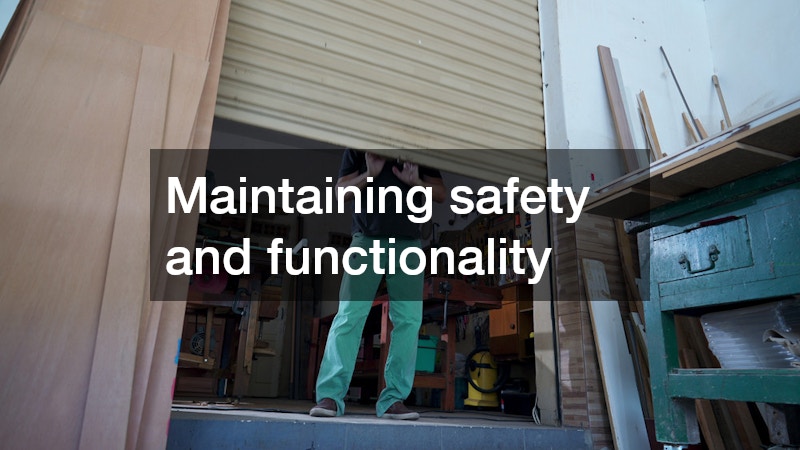Garage doors are an integral part of your home, and ensuring their proper maintenance is crucial for the safety and efficiency of your household. But how often should you schedule a garage door service? This article delves into the key considerations and best practices for maintaining your garage door in optimal condition.
Signs That Your Garage Door Needs Servicing
Unusual noises and movements
Garage doors often communicate their need for servicing through sounds and actions. If you hear grinding, squeaking, or clunking noises, these are usually indicative of mechanical issues.
Similarly, irregular movements such as jerking or not opening smoothly can signal problems that require professional attention.
The moving parts of a garage door, including springs and cables, can suffer from wear, leading to these disturbances. Ignoring these signs can exacerbate the issue, potentially leading to a complete malfunction. Therefore, it is crucial to be attentive to these auditory and motion cues to schedule timely maintenance and prevent a future breakdown.
Routine attention to these elements not only improves functionality but also enhances the safety of the door’s operation. Regular lubrication of moving parts can alleviate some noises, but a professional service will thoroughly inspect and address any underlying causes. Therefore, staying vigilant about such changes is pivotal to maintaining your garage door’s health and efficiency.
Physical wear and tear
Physical wear and tear on garage doors can also indicate the need for servicing. Cracks, dents, and rust are visible signs that certain components are wearing out and may require replacement. It’s essential to inspect the door panels, hinges, and tracks regularly, assessing these areas for damage.
Though some minor wear might seem harmless, it can quickly escalate into significant issues if left unattended. For instance, damaged weather stripping can affect the door’s insulation, leading to energy inefficiency. Prompt attention to visible wear helps prevent more severe problems, which could demand costly repairs.
In addition to visual inspections, regularly checking the door’s balance by manually operating it can reveal hidden issues. A door that doesn’t remain open when lifted halfway may need spring adjustment or replacement. Consequently, routine evaluations play a crucial role in intercepting potential problems early.
How Often Should Routine Maintenance Be Performed?
Recommended service intervals
For most homes, scheduling a professional garage door service at least once a year is advised to maintain optimal performance. Professional inspections are thorough, covering all mechanisms such as springs, cables, rollers, and door openers. These inspections help identify any looming issues that might not be immediately apparent to the untrained eye.
Unfortunately, many homeowners delay these routine check-ups until a serious problem arises. Preventive maintenance is key to avoiding unexpected failures that could hamper the convenience and safety of your garage door system. A yearly appointment with a technician can save you from the stress and additional costs associated with emergency repairs.
Importance of seasonal checks
Seasonal changes impose varying demands on a garage door, necessitating specific checks to adapt to these conditions. In colder months, metal components can contract, while warmer temperatures can cause expansion, affecting movement. Moreover, fluctuating weather patterns can wear out the weather stripping and seals, diminishing your door’s efficiency.
Conducting seasonal checks helps address these issues, ensuring each component is prepared to handle environmental stresses. A focus on the door’s bottom seal and track alignment is particularly essential before winter to prevent freezing and jamming. Similarly, in spring, you might need to clear debris and apply fresh lubrication to accommodate the change from winter.
The Benefits of Regular Garage Door Maintenance
Enhancing durability and lifespan
Regular maintenance plays a significant role in enhancing the durability and lifespan of your garage door. Just like with any mechanical system, consistent care ensures that each component operates smoothly and lasts longer. Addressing issues promptly and keeping the system well-lubricated reduces strain on parts, delaying deterioration.
Moreover, periodic professional check-ups can pinpoint components that need replacement before they fail. This preventive approach is particularly advantageous because it mitigates the risk of a full breakdown that might require a complete door replacement. Thus, well-maintained doors remain serviceable for many years beyond their expected lifespan.
Maintaining safety and functionality
The safety and functionality of a garage door are paramount, particularly since the door is a primary entrance in many households. Regular service ensures that safety mechanisms, including auto-reverse functions, sensors, and manual overrides, are operational. A malfunction in any of these features poses serious safety risks, especially in a household with children or pets.
Functionality, too, is a key consideration because a garage door should open smoothly and efficiently without resistance or delay. Regular inspections and maintenance catch potential problems that might affect these operations, such as misaligned tracks or a weakened motor. In this way, routine care secures both convenience and security daily.
Routine garage door maintenance not only ensures safety and efficiency but also extends the lifespan of your door. By recognizing signs of wear, adhering to recommended servicing schedules, and appreciating the benefits of regular maintenance, you can ensure your garage door remains in prime condition. Ultimately, this diligence reflects a commitment to the safety, functionality, and value of your household’s essential entryway.



